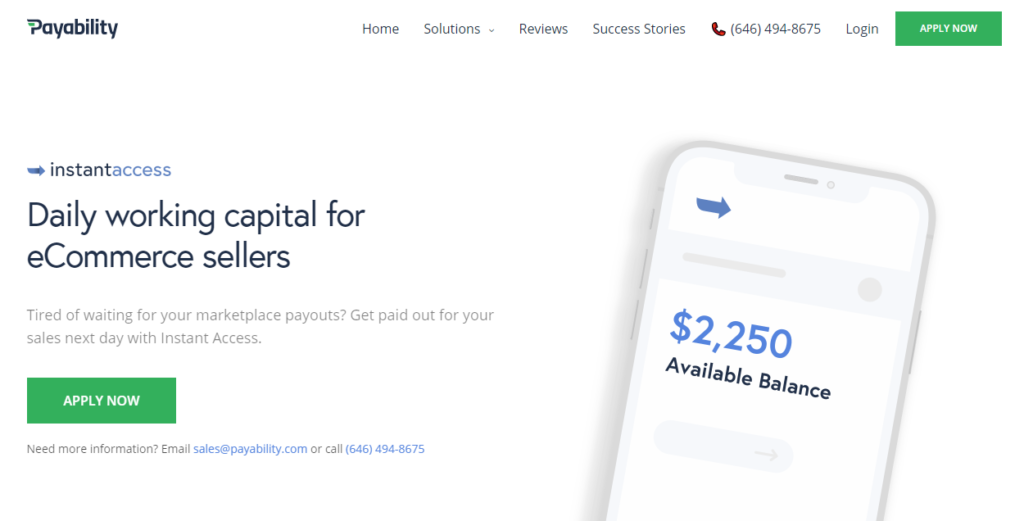If you run an online marketplace business, you’ll be familiar with the concept of working capital
Whether you have multiple listings on Amazon or a boutique store on Etsy, ensuring a steady flow of working capital is essential for long-term retail success. Marketplace sellers that find themselves short on cash will struggle to replenish stock, fail to fulfill orders, and see their product rankings slowly slip away.
But even for successful merchants, the task of maintaining adequate levels of working capital isn’t always easy. Unexpected costs relating to seasonal demand, spoiled stock, disrupted supply chains (yep, we’re thinking of coronavirus), late delivery and more can quickly add up. And merchants oriented towards growth face the added challenge of balancing medium and long-term investments with day-to-day costs.
In this post, we’re going to take a look at the concept of working capital, how to implement sustainable practices, and which solutions are on offer to help businesses that need a boost.
What is working capital?
The term ‘working capital’ refers to a company’s current (liquid) assets minus any current liabilities, like upcoming invoices.
For most companies, working capital is essentially the amount of cash in their business account combined with the value of inventory. This is the money they can be ‘put to work’ to run their business.
Let’s say, for example, that Giant Party Hats Online Inc. has $10,000 (£8045) in the bank. It owes its suppliers $1000 (£800) and also expects to receive payment on an invoice for $500 (£399). The company’s total working capital is $9500 (£7,635).
How does working capital help online marketplace businesses?
Online marketplace businesses have a multitude of cash-intensive responsibilities, including the need to maintain consistent levels of stock, invest in advertising and brand awareness, process returns, develop product lines, provide customer support, manage deliveries and more. All of these tasks mean that working capital is absolutely essential.
A company’s working capital ratio is often used to gauge its short-term financial health and general efficiency. So, for example, if a company has $10,000 of liquid assets and owes $5000 to its suppliers, it has a ratio of 2.
A ratio of between 1.2 and 2 is generally seen as positive. A ratio below 1.2 indicates that a company will likely have trouble paying all its debts while a figure above 2 signals unnecessarily low levels of investment.
The benefits of effective business practices in this area are numerous. Merchants with a steady level of working capital are able to maintain optimal inventory and supply channels secure in the knowledge that they have a safety net in an emergency. Furthermore, a well-managed approach to current assets allows for long-term growth and expansion.
How can marketplace businesses avoid working capital pitfalls?
There are a number of common pitfalls that marketplace merchants should watch out for. Accounting for the most common ones will help you manage your working capital more efficiently.
Here are the main ways you can optimise your current practices:
- Avoid overstocking inventory – While inventory comprises part of your working capital, it’s a more vulnerable asset than cash. Avoid overstocking when there isn’t a threat to the supply chain.
- Develop good relationships with vendors – Good agreements with vendors are excellent safeguards against working capital problems, especially if you need to delay payment.
- Account for seasonal variance – Failure to adjust expenditure and allocate resources appropriately with high-peak and low-peak buying periods in mind can be disastrous for merchants.
- Create supply chain contingencies – Do you have contingencies for bad vendors, disrupted supply routes, and unexpected upheavals in the broader market (like product withdrawals)?
- Make smart investment choices – If you have a working capital ratio above two, you’re likely not making intelligent investments in the growth of your company.
Top five working capital solutions in 2020
If you’re an online marketplace retailer looking for a boost to your working capital, there are numerous solutions available to you.
And you don’t need to opt for a straightforward small business loan, either. A new and innovative solution aimed specifically at ecommerce businesses called a merchant cash advance has become available in the last few years.
Here are five of the top providers:
Payoneer

Payoneer offers a straightforward and competitively-priced solution for marketplace businesses on Amazon and Walmart. Advances of up to $500,000 (£402,535) are offered, based on a number ‘store health indicators’ which include monthly revenue, order defect rate, length of time trading and more. It’s a dedicated solution for marketplace sellers and easily one of the best options on the market.
As with most merchant cash advance providers, Payoneer works by taking a direct cut from card payments made by customers, currently set at 35pc. Payoneer is notable because of the smooth process of funding, it’s very competitive on price and fees can be as low as 2.5pc of the funding amount.
Lendr

Lendr offers merchant capital advances to companies that have been in business for at least a year with more than $10,000 (£8045) in revenue and a credit score above 500. Advances of between $5000 (£4013) and $500,000 (£402,745) are offered so it’s a great option for small and large retailers alike.
Lendr takes a percentage of credit and debit card sales until the loaned amount is fully repaid. The application is straightforward and Lendr has a high approval rate, so it’s a solution well worth checking out.
Payability

Payability is a solution aimed at marketplace sellers on Walmart and Amazon. Merchants that qualify for ‘Daily Working Capital’ will receive the equivalent of 80pc of the previous day’s sales (rather than at the end of the month when revenue is paid out). Applicants must have been selling for at least three months with monthly revenues of $2000 (£1,603).
For retailers that want to take a more incremental approach (instead of receiving a lump sum), Payability is a great choice.
SellersFunding

SellersFunding is a working capital provider that caters exclusively to Amazon retailers. It’s completely open about its pricing model and offers advances of up to £250,000 to FBA sellers in the UK.
Application and approval usually takes around one day and the lower threshold for rates is 3pc. There’s also a 90-day grace period before repayment starts, which many retailers will find appealing.
Kabbage

Kabbage is a good choice for smaller merchants and advances can be as low as $2000 (£1,603). One negative is that fees tend to be higher compared to other lenders. Merchants looking for short-term working capital, however, will like the quick approval time and straightforward payment options. Working capital solutions of up to $250,000 (£201,290) are available.
Conclusion
Running a marketplace business isn’t easy. And the absence of tailored financial solutions available to retailers struggling with working capital didn’t help.
But fortunately things are changing. More providers are offering dedicated solutions, whether in the form of short-term loans or capital advances, that enable sellers to manage day-to-day running costs while growing their product lines.
Marketplace retailers that understand these solutions, and when to use them, will be poised for succss in the coming years.





